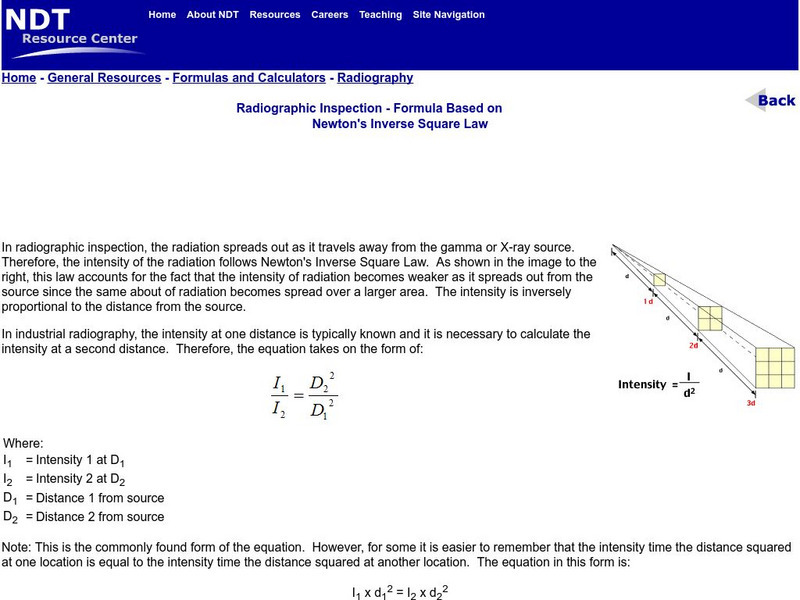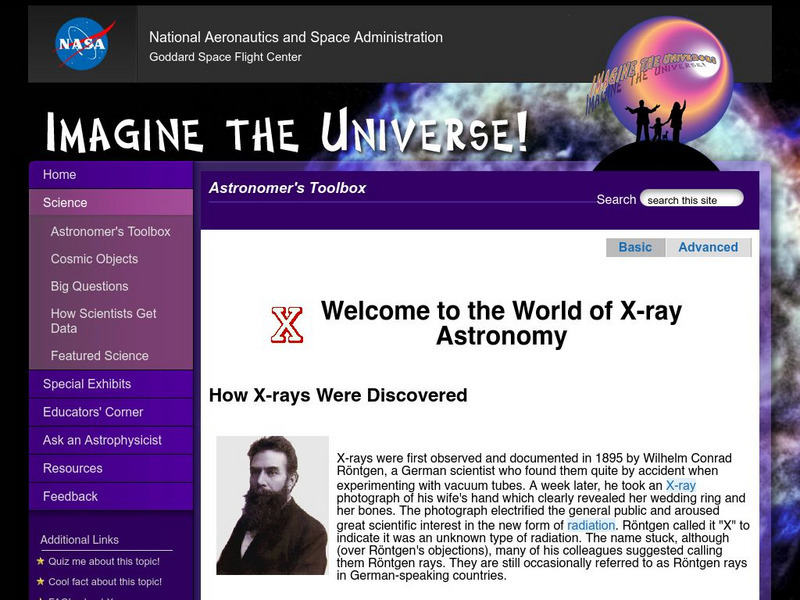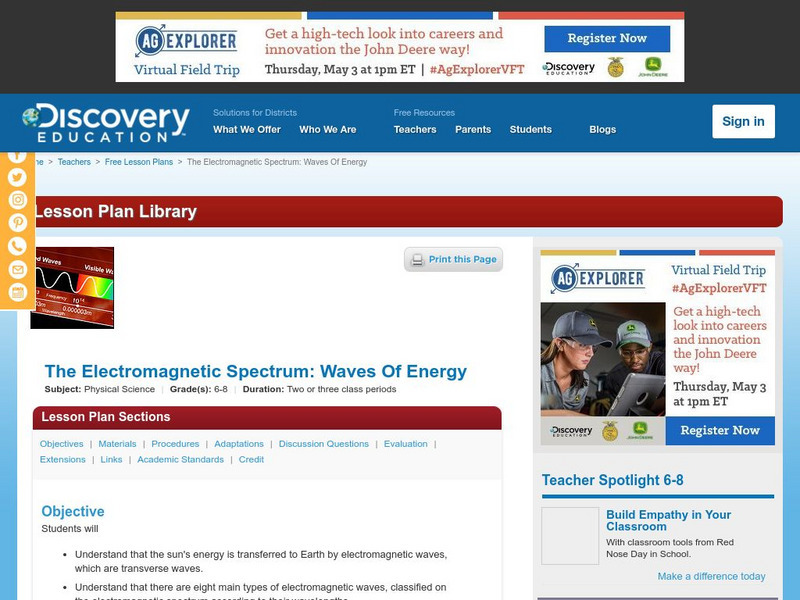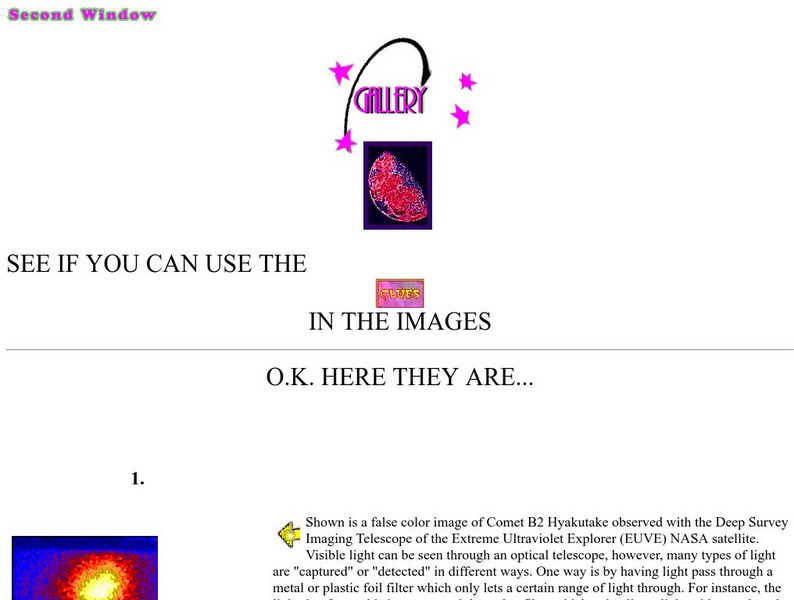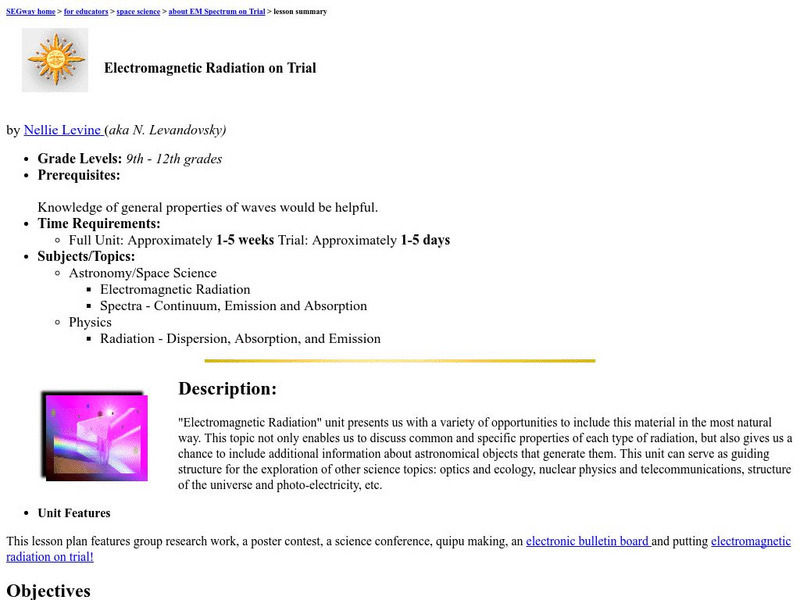WebMD
Medicine Net: Computerized Axial Tomography
This site from MedicineNet.com gives a CAT Scan description, why they're performed, risks, and patient preparation. A thoughrough explanation of the process is provided.
Other
Nondestructive Testing Resource Center: Radiographic Inspection
This tutorial helps students learn about Radiographic Inspection through the concept of Newton's Inverse Square Law.
National Health Museum
Radioactivity: Historical Figures
A summary of the contributions of Wilhelm Roentgen, Antione Henri Becquerel, Marie Curie, and Ernest Rutherford on radioactivity.
NASA
Nasa: Imagine the Universe: Welcome to the World of X Ray Astronomy
Site recounts how X-rays were discovered as well as who discovered them. Offers graphics, links to facts on this topic, a quiz, and teacher resources.
NASA
Nasa: Imagine the Universe: The History of Gamma Ray Astronomy
This NASA article discusses the history of gamma-ray astronomy. Related resources.
Careers New Zealand
Kiwicareers: Radiation Oncologist
KiwiCareers offers a very informative site about the duties of an oncologist. Even though it was written for a New Zealand audience, the principles are the same.
Nobel Media AB
The Nobel Prize: The Nobel Prize in Physics 1901: William Conrad Rontgen
In 1901, Wilhelm Conrad Rontgen won the Nobel Prize for Physics because of his work with the x-ray. The site includes a picture of Rontgen along with biographical information, his Nobel lecture, and other resources, such as illustrated...
Other
Translating Virtual Reality Into Physical Reality
A fascinating site which demonstrates the application of X-ray technology and other medical imaging techniques. Site explores how CT scans can be used to create models of the human body. Several pages with incredible graphics and...
Discovery Education
Discovery Education: The Em Spectrum: Waves of Energy
Students are introduced to the electromagnetic spectrum through this group research activity. Each group investigates a different wavelength range within the em spectrum and reports back to class. Discussion ideas also included.
TED Talks
Ted: Ted Ed: Is Radiation Dangerous?
Matt Anticole describes the different types of radiation. [5:20]
Massachusetts Institute of Technology
Mit: Invention of the Week: Albert Macovski: Medical Imaging Systems
Learn about the work done by Albert Macovski, which included the development of digital radiography, ultrasound, and magnetic resonance imaging (MRI), and learn how these inventions impact the medical world.
Other
Why Did I Choose to Become a Radiologist?
This is a great site the discusses the role of a radiologist as well as the instruments they use, what conditions they treat, and much more.
Harvard University
Harvard Univ.: Chandra X Ray Observatory Center
The Chandra Observatory uses x-ray telescopes to learn more about the make-up of the universe. To learn more about x-ray telescopes and to see what they reveal, click here for the official Chandra X-ray Observatory website.
NASA
Viewing the Violent Universe: What Are Gamma Rays?
The universe produces a broad range of light, only a fraction of which is visible to our eyes. Gamma rays are nonvisible light, which also includes x-rays, ultraviolet light, infrared radiation, and radio waves.
University of California
Center for Science Education: Gallery
A gallery of astronomy images which depict galaxies, comets, the moon, planets, nebulae, supernovae as seen in various regions of the electromagnetic spectrum. Each image in the gallery is described. Fascinating!
University of Colorado
University of Colorado: Physics 2000: X Rays
Here's a really simple demonstration of a fluoroscope. There are links to more information about the uses of X-rays as well.
University of Colorado
University of Colorado: Physics 2000: Cat Scans
A CAT Scan is compared to cutting up a fruitcake on this basic, yet interesting site. This description of CAT Scans is intended for a younger audience and also offers links to the visible human project.
Wikimedia
Wikipedia: Wilhelm Rontgen
This site from the Wikipedia encyclopedia provides a biography on Wilhelm Rontgen discusses his discovery of what became known as x-rays. The article also provides some information on his education and achivements throughout his life.
National Inventors Hall of Fame
National Inventors Hall of Fame: William D. Coolidge: Vacuum Tube (X Ray)
This site provides a brief biography on William D. Coolidge, inventor of the X-ray tube, also known as the "Coolidge tube."
University of California
Center Science Edu.: Electromagnetic Radiation on Trial
Here is a 1-5 day unit on electromagnetic radiation that features a teacher guide and student activities with extensions.



